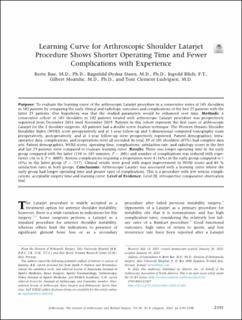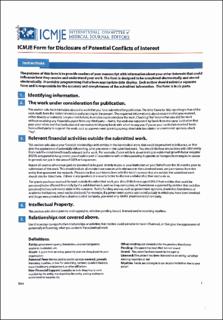| dc.contributor.author | Bøe, Berte Marie Grimsmo | |
| dc.contributor.author | Støen, Ragnhild Øydna | |
| dc.contributor.author | Blich, Ingvild | |
| dc.contributor.author | Moatshe, Gilbert | |
| dc.contributor.author | Ludvigsen, Tom Clement | |
| dc.date.accessioned | 2022-09-01T12:11:33Z | |
| dc.date.available | 2022-09-01T12:11:33Z | |
| dc.date.created | 2022-05-25T10:49:36Z | |
| dc.date.issued | 2022 | |
| dc.identifier.citation | Arthroscopy: The Journal of Arthroscopic and Related Surgery. 2022, 38(8), Side 2391-2398. | en_US |
| dc.identifier.issn | 0749-8063 | |
| dc.identifier.uri | https://hdl.handle.net/11250/3015155 | |
| dc.description | This is an open access article under the CC BY license (http://creativecommons.org/licenses/by/4.0/). | en_US |
| dc.description.abstract | Purpose: To evaluate the learning curve of the arthroscopic Latarjet procedure in a consecutive series of 103 shoulders in 102 patients by comparing the early clinical and radiologic outcomes and complications of the first 25 patients with the latter 25 patients. Our hypothesis was that the studied parameters would be enhanced over time.
Methods: A consecutive cohort of 103 shoulders in 102 patients treated with arthroscopic Latarjet procedure was prospectively registered from December 2014 until November 2019. Patients in this cohort represent the first cases of arthroscopic Latarjet for the 2 shoulder surgeons. All patients had a double screw fixation technique. The Western Ontario Shoulder Instability Index (WOSI) score preoperatively and at 1-year follow-up and 3-dimensional computed tomography scans preoperatively, postoperatively, and at 1-year follow-up were prospectively registered. Patient demographics, intraoperative data, complications, and reoperations were all recorded. In total, 85 of 103 shoulders (83%) had complete data sets. Patient demographics, WOSI scores, operating time, complications, satisfaction rate, and radiology scores in the first and last 25 patients were compared to evaluate learning curve.
Results: There was longer operating time in the early group compared with the latter (130 vs 105 minutes, P = .001) and number of complications was reduced with experience (16 vs 4, P = .0005). Serious complications requiring a reoperation were 4 (16%) in the early group compared to 1 (4%) in the latter group (P = .157). Clinical results were good with major improvement in WOSI scores and 84 % satisfaction rates in both groups.
Conclusions: Arthroscopic Latarjet was associated with a learning curve where the early group had longer operating time and greater rates of complications. This is a procedure with few serious complications, acceptable surgery time and learning curve.
Level of Evidence: Level III, retrospective comparative observation trial. | en_US |
| dc.language.iso | eng | en_US |
| dc.subject | arthroscopy | en_US |
| dc.subject | complications | en_US |
| dc.subject | Latarjet | en_US |
| dc.subject | learning curve | en_US |
| dc.subject | operating time | en_US |
| dc.subject | shoulder | en_US |
| dc.title | Learning curve for arthroscopic shoulder Latarjet procedure shows shorter operating time and fewer complications with experience | en_US |
| dc.title.alternative | From open to arthroscopic Latarjet: An evaluation of the learning curve of the first 103 cases shows shorter operating time and fewer complications with experience | en_US |
| dc.type | Peer reviewed | en_US |
| dc.type | Journal article | en_US |
| dc.description.version | publishedVersion | en_US |
| dc.rights.holder | © 2022 The Author(s) | en_US |
| dc.source.pagenumber | 2391-2398 | en_US |
| dc.source.volume | 38 | en_US |
| dc.source.journal | Arthroscopy: The Journal of Arthroscopic and Related Surgery | en_US |
| dc.source.issue | 8 | en_US |
| dc.identifier.doi | 10.1016/j.arthro.2022.01.042 | |
| dc.identifier.cristin | 2027266 | |
| dc.description.localcode | Institutt for idrettsmedisinske fag / Department of Sports Medicine | en_US |
| cristin.ispublished | true | |
| cristin.fulltext | original | |
| cristin.qualitycode | 2 | |

